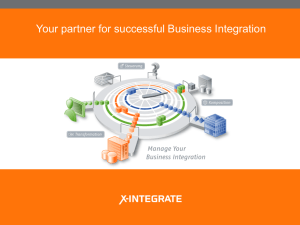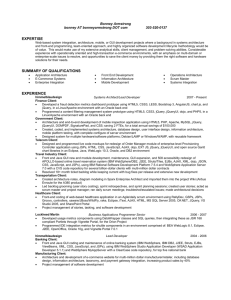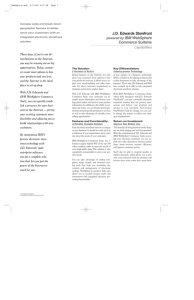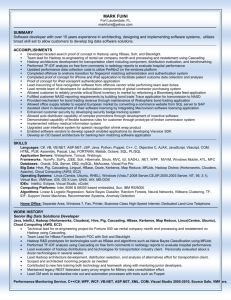Download PDF (0.1 MB)
advertisement
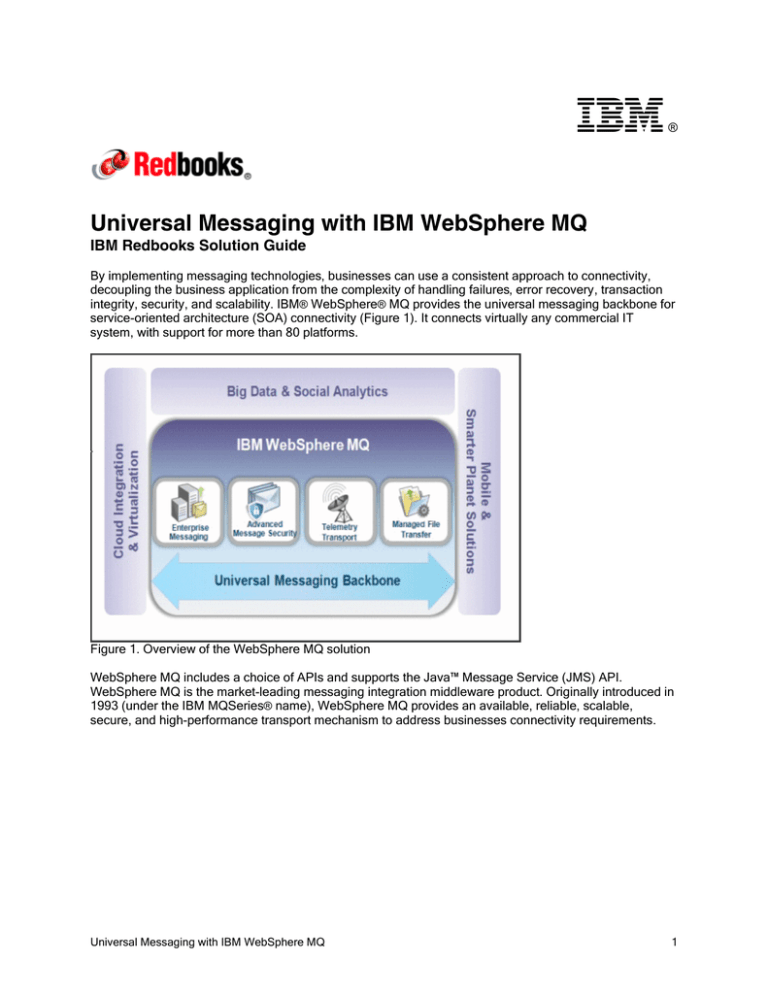
® Universal Messaging with IBM WebSphere MQ IBM Redbooks Solution Guide By implementing messaging technologies, businesses can use a consistent approach to connectivity, decoupling the business application from the complexity of handling failures, error recovery, transaction integrity, security, and scalability. IBM® WebSphere® MQ provides the universal messaging backbone for service-oriented architecture (SOA) connectivity (Figure 1). It connects virtually any commercial IT system, with support for more than 80 platforms. Figure 1. Overview of the WebSphere MQ solution WebSphere MQ includes a choice of APIs and supports the Java™ Message Service (JMS) API. WebSphere MQ is the market-leading messaging integration middleware product. Originally introduced in 1993 (under the IBM MQSeries® name), WebSphere MQ provides an available, reliable, scalable, secure, and high-performance transport mechanism to address businesses connectivity requirements. Universal Messaging with IBM WebSphere MQ 1 Did you know? IBM WebSphere MQ has the following credentials and industry recognition: It is the most widely deployed messaging backbone, with over 10,000 customers using the IBM Messaging Backbone: o Over 90 percent of Fortune 50 companies and of Fortune 10 companies use the IBM Messaging Backbone. o Over 80 percent of Global 25 companies and 70 percent of Global 10 companies use the IBM Messaging Backbone. It is entrusted with tens of billions of messages each day: o A government client sends 675 million messages per day. o A banking client handles over 213 million messages per day on IBM z/OS® alone. It is relied upon as the mission-critical backbone: o A financial markets client handles US$1 trillion worth of traffic per day on one WebSphere MQ network. o A banking client sends US$7 - US$35 trillion worth of traffic per day on just one WebSphere MQ-based SWIFT gateway. Business value Business environments are constantly changing. Applications that were written 20 years ago need to exchange data with applications that were written last week. With WebSphere MQ, businesses can respond quickly to the constantly changing environment by reducing the need to change existing applications to connect them to new ones. Businesses can use and extend the life of existing applications by enabling wider sharing of business data. They can also manage complexity through end-to-end visibility of data movement across all systems and applications. By using WebSphere MQ, companies can create a robust IT infrastructure that supports SOAs, providing businesses with the reliability and flexibility that they require. Application developers can concentrate on solving business problems and adding value to the business, while relying on the messaging backbone that is provided by WebSphere MQ to handle the technical aspects of application connectivity and integration. Most businesses today require services, such as managing payments or querying account information, to be made available through a range of channels. The core data can be held in a database on a mainframe, but a user of a browser requires a front-end web application server to interact with that database. As new delivery channels are created, such as smartphone applications, easy ways are needed for that new mechanism to interact. The smartphone application must communicate with the same applications and database without changes. WebSphere MQ Telemetry extends WebSphere MQ through clients by using MQ Telemetry Transport (MQTT), which is a standard lightweight connectivity protocol. It enables connected physical devices and mobile devices, which might be restricted by bandwidth and power consumption, to exchange information with WebSphere MQ. Universal Messaging with IBM WebSphere MQ 2 Solution overview WebSphere MQ has always been in the business of connecting systems and applications together, regardless of platform or environment. Now the range of environments in which WebSphere MQ can or must live has changed. Newer platforms, environments, requirements for qualities of service, and newer messaging patterns are available. Security has become more important as systems are made accessible to more users across an enterprise and beyond it. Performance and scalability requirements have increased. Regulators and auditors have imposed more controls on what can or must be done. Systems, which need access to enterprise data, have become both more powerful (faster and more processors) and much less powerful (sensors, tablets, and mobile phones). Therefore, WebSphere MQ has evolved. WebSphere MQ includes the following features (illustrated in Figure 1) that enable business to connect all their assets in all possible ways: With WebSphere MQ Advanced Message Security (AMS), customers can protect the security of their messages from application to application, without needing to change the application code itself. IBM WebSphere MQ Telemetry is a feature of IBM WebSphere MQ that extends the universal messaging backbone with the MQTT protocol to a wide range of remote sensors, actuators, and telemetry devices. MQTT is a messaging protocol that is lightweight enough to be supported by the smallest devices, yet robust enough to ensure that important messages get to their destinations every time. With the MQTT protocol, such devices as smart energy meters, cars, trains, satellite receivers, and personal healthcare devices, can communicate with each other and with other systems or applications. WebSphere MQ Managed File Transfer (MQMFT) provides the ability for customers to move their business data stored in files over the WebSphere MQ infrastructure, improving the reliability, security, and management of their file transfers. Enterprise messaging is still the core function of WebSphere MQ. At the same time as adding new interfaces, protocols, and environments, a large amount of WebSphere MQ workload continues to run in mainframe-based data centers. Efficient use of, and integration with, the capabilities of the IBM System z® hardware and operating systems is critical. WebSphere MQ V7.1 for z/OS significantly improves the performance, capacity, and availability that can be achieved when running in a sysplex. WebSphere MQ V7.1 has many new features. The benefits are real and customers have made this version the most accepted and fastest version-to-version migration in the product history. Many new features introduced in the new releases are the result of customer requirements. The following features have received much positive customer feedback: Multiple installation support A key new feature of WebSphere MQ V7.1 is the ability to install WebSphere MQ in different locations on your system. This feature enables multiple versions to be installed at the same time, which can aid in migration, either between releases or when installing fix packs. This feature also enables support for applications that require different releases of WebSphere MQ. IBM z/OS shared message data sets A new design for how large messages on shared queues are stored has improved performance, reduced processor costs, and increased the capacity of these queues. This feature is known as shared message data set. Reducing millions of instructions per second (MIPS) is a key advantage of this feature. This enhancement uses Virtual Storage Access Method (VSAM) instead of IBM DB2® binary large objects (BLOBs). Universal Messaging with IBM WebSphere MQ 3 Data is transferred between applications in messages (Figure 2). Figure 2. Basic WebSphere MQ components to connect applications Universal Messaging with IBM WebSphere MQ 4 A message is a container that consists of three parts: MQ Message Descriptor (MQMD) identifies the message and contains additional control information. Examples of additional information are the type of message and the priority that is assigned to the message by the sending application. Message properties are an optional set of user-definable elements that describe the message without being part of the payload. Applications that receive messages can choose whether to inspect these properties. Message data contains the application data. The structure of the data is defined by the application programs that use it, and WebSphere MQ is largely unconcerned with its format or content. Currently 12 types of objects can be configured in WebSphere MQ, in addition to many other resources (for example security access controls, or subscriptions) that are managed by WebSphere MQ. The most important objects from this set are the queue manager itself, queues, channels, and topics. The nodes within a WebSphere MQ message queuing infrastructure are called queue managers. The queue manager is responsible for accepting and delivering messages. Multiple queue managers can run on a single physical server or on a wide network of servers across many various hardware and operating system platforms. Each queue manager provides facilities for reliable messaging. The queue manager maintains queues of all messages that are waiting to be processed or routed. Queue managers are tolerant of failures and maintain the integrity of business-critical data that flows through the message queuing infrastructure. If a failure occurs (such as with the queue manager, machines, or power loss), the messages can be recovered. The queue managers, within the infrastructure, are connected by logical channels over a communications network. Messages automatically flow across these channels from the initial producer of a message to the eventual use of that message, based on the configuration of the queue managers in the infrastructure. Changes can be made to the configuration of queues and channels transparently for the applications. For example, a receiving application can be moved to a new machine, and a route to that machine can be defined without needing any changes to sending applications. Solution architecture The architecture for a solution that is based on WebSphere MQ depends on the business requirements and applications that it supports. One flexible approach is to join many queue managers in a dynamic logical network called a queue manager cluster. A cluster allows multiple instances of the same service to be hosted through multiple queue managers. Applications that request a particular service can connect to any queue manager within the queue manager cluster. When applications make requests for the service, the queue manager to which they are connected uses a workload balancing algorithm to spread these requests across all available queue managers that host an instance of that service. Universal Messaging with IBM WebSphere MQ 5 Figure 3 illustrates workload balancing in a WebSphere MQ cluster. The message sent from Application A can be processed by any instance of Application Z. The cluster chooses one of the routes based on various criteria, including knowledge of which route it previously chose and which routes are available. Figure 3. Workload balancing in a WebSphere MQ cluster Usage scenarios The following scenarios show three ways in which IBM WebSphere MQ was used to solve real-world problems: Retail kiosk A retailer wanted to respond rapidly to online customer needs and have a consistent view of data shown at more than 25,000 self-service kiosks. Data changes rapidly and must be distributed rapidly to these kiosks. The network of kiosks was connected by a messaging service to the central databases, and changes are now pushed out rapidly. More than 14,000 transactions are processed each second. Faster bank payments Government regulations that limit payment clearing times require faster payment processes through near-instant money transfers between banks. Universal Messaging with IBM WebSphere MQ 6 A high-performance payment solution was developed by using a messaging backbone to route message traffic between systems. Many existing components of the older payment system were adapted to work with the new messaging layer, preserving investment in these programs. The government requirement can clear payments in under two hours. However, this solution is technically capable of completing its processing in seconds. It handles millions of transactions every day. Airport Information At an airport, rapid changes in government regulations are coupled with increasing passenger volumes. This airport needed a flexible IT infrastructure that is populated with seamlessly integrated systems. The airport was supporting daily business operations with an inflexible heterogeneous infrastructure. A messaging-based solution was implemented that establishes a shared integration layer and enables the seamless flow of multiple data types between the client’s heterogeneous systems. For example, airport staff can now easily access important information, such as flight schedule changes from multiple systems. The airport can also flexibly integrate new systems to accommodate evolving government regulations. Integration IBM WebSphere MQ is at the core of the SOA Message Backbone, and any-to-any connectivity is its core value. WebSphere MQ does not require the use of any other products. However, two products are frequently used alongside WebSphere MQ: WebSphere Message Broker WebSphere Application Server Integration with WebSphere Message Broker Enterprise systems consist of many logical endpoints, such as off-the-shelf applications, services, packaged applications, web applications, devices, appliances, and custom built software. These endpoints use a set of inputs and outputs: Connection protocols such as MQ, TCP/IP, database, HTTP, files, FTP, SMTP, and POP3 Data formats such as C or COBOL structures, XML, industry-specific (SWIFT, EDI, HL7), and user-defined formats An enterprise service bus (ESB) can be imagined as something that runs at the center of this wide range of connections, applications, and protocols. It performs such tasks as routing and data transformation, so that any endpoint can communicate with any other endpoint. Traffic passes through an ESB, without requiring a complex and unmaintainable mesh of individual point-to-point connections. WebSphere Message Broker is an ESB product that connects these endpoints in meaningful ways, to simplify application and device integration. This connection requires WebSphere MQ to also be installed on systems where it runs. This requirement is partly because applications that are enabled for WebSphere MQ are an important class of connectivity that it must support. The requirement is also because it uses queue manager-provided services such as transaction coordination, publish/subscribe, and the reliable storage of messages. As an example of how WebSphere Message Broker makes integration simple, consider a typical retail enterprise. Such an enterprise has many different end points, both inside and outside the organization, with data in multiple formats and protocols, such as TLOG, files, JSON/HTTP. As new capabilities need to blend in (such as support for mobile applications and analytics), the flexibility of WebSphere Message Broker makes it simple to add these functions without disrupting existing services. Universal Messaging with IBM WebSphere MQ 7 Integration with WebSphere Application Server The WebSphere Application Server product hosts and runs applications. At its core, it is a Java Platform, Enterprise Edition (Java EE) environment, which implements and supports a range of open standards. One such standard that Java EE applications often use is the Java Message Service (JMS). WebSphere Application Server includes the runtime Java client code and the administration panels that make it easy to connect to a WebSphere MQ queue manager. This way, web applications can reliably send messages to, and get responses from, any other MQ-enabled application that might be running in the enterprise. Supported platforms WebSphere MQ helps to integrate virtually anything, with support for more than 80 platform configurations. For information about the supported platforms, see the System Requirements for WebSphere MQ at: http://ibm.com/software/integration/wmq/requirements Ordering information Table 1 shows the ordering information. Table 1. Part numbers and feature codes Program name PID number Charge unit description WebSphere MQ for Multiplatform 5724-H72 Per Processor Value Unit (PVU) for Linux on System z Per PVU PROCESSOR-Day Related information For more information, see the following documents: IBM WebSphere MQ V7.1 and V7.5 Features and Enhancements, SG24-8087 http://www.redbooks.ibm.com/abstracts/sg248087.html IBM WebSphere MQ Primer, REDP0021 http://www.redbooks.ibm.com/abstracts/redp0021.html?Open WebSphere MQ product page http://ibm.com/software/integration/wmq IBM announcement letters and sales manuals http://www.ibm.com/common/ssi/index.wss?request_locale=en On this page, enter IBM WebSphere MQ for z/OS V7.1 or WebSphere MQ for Multiplatform, and click Search. On the next page, narrow your search results by information type, geography, language, or all three options. Universal Messaging with IBM WebSphere MQ 8 Notices This information was developed for products and services offered in the U.S.A. IBM may not offer the products, services, or features discussed in this document in other countries. Consult your local IBM representative for information on the products and services currently available in your area. Any reference to an IBM product, program, or service is not intended to state or imply that only that IBM product, program, or service may be used. Any functionally equivalent product, program, or service that does not infringe any IBM intellectual property right may be used instead. However, it is the user's responsibility to evaluate and verify the operation of any non-IBM product, program, or service. IBM may have patents or pending patent applications covering subject matter described in this document. The furnishing of this document does not give you any license to these patents. You can send license inquiries, in writing, to: IBM Director of Licensing, IBM Corporation, North Castle Drive, Armonk, NY 10504-1785 U.S.A. The following paragraph does not apply to the United Kingdom or any other country where such provisions are inconsistent with local law : INTERNATIONAL BUSINESS MACHINES CORPORATION PROVIDES THIS PUBLICATION "AS IS" WITHOUT WARRANTY OF ANY KIND, EITHER EXPRESS OR IMPLIED, INCLUDING, BUT NOT LIMITED TO, THE IMPLIED WARRANTIES OF NON-INFRINGEMENT, MERCHANTABILITY OR FITNESS FOR A PARTICULAR PURPOSE. Some states do not allow disclaimer of express or implied warranties in certain transactions, therefore, this statement may not apply to you. This information could include technical inaccuracies or typographical errors. Changes are periodically made to the information herein; these changes will be incorporated in new editions of the publication. IBM may make improvements and/or changes in the product(s) and/or the program(s) described in this publication at any time without notice. Any references in this information to non-IBM Web sites are provided for convenience only and do not in any manner serve as an endorsement of those Web sites. The materials at those Web sites are not part of the materials for this IBM product and use of those Web sites is at your own risk.IBM may use or distribute any of the information you supply in any way it believes appropriate without incurring any obligation to you. Information concerning non-IBM products was obtained from the suppliers of those products, their published announcements or other publicly available sources. IBM has not tested those products and cannot confirm the accuracy of performance, compatibility or any other claims related to non-IBM products. Questions on the capabilities of non-IBM products should be addressed to the suppliers of those products. This information contains examples of data and reports used in daily business operations. To illustrate them as completely as possible, the examples include the names of individuals, companies, brands, and products. All of these names are fictitious and any similarity to the names and addresses used by an actual business enterprise is entirely coincidental. Any performance data contained herein was determined in a controlled environment. Therefore, the results obtained in other operating environments may vary significantly. Some measurements may have been made on development-level systems and there is no guarantee that these measurements will be the same on generally available systems. Furthermore, some measurement may have been estimated through extrapolation. Actual results may vary. Users of this document should verify the applicable data for their specific environment. COPYRIGHT LICENSE: This information contains sample application programs in source language, which illustrate programming techniques on various operating platforms. You may copy, modify, and distribute these sample programs in any form without payment to IBM, for the purposes of developing, using, marketing or distributing application programs conforming to the application programming interface for the operating platform for which the sample programs are written. These examples have not been thoroughly tested under all conditions. IBM, therefore, cannot guarantee or imply reliability, serviceability, or function of these programs. © Copyright International Business Machines Corporation 2012. All rights reserved . Note to U.S. Government Users Restricted Rights -- Use, duplication or disclosure restricted by GSA ADP Schedule Contract with IBM Corp. Universal Messaging with IBM WebSphere MQ 9 This document was created or updated on December 7, 2012. Send us your comments in one of the following ways: Use the online Contact us review form found at: ibm.com/redbooks Send your comments in an e-mail to: redbook@us.ibm.com Mail your comments to: IBM Corporation, International Technical Support Organization Dept. HYTD Mail Station P099 2455 South Road Poughkeepsie, NY 12601-5400 U.S.A. This document is available online at http://www.ibm.com/redbooks/abstracts/tips0925.html . Trademarks IBM, the IBM logo, and ibm.com are trademarks or registered trademarks of International Business Machines Corporation in the United States, other countries, or both. These and other IBM trademarked terms are marked on their first occurrence in this information with the appropriate symbol (® or ™), indicating US registered or common law trademarks owned by IBM at the time this information was published. Such trademarks may also be registered or common law trademarks in other countries. A current list of IBM trademarks is available on the Web at: http://www.ibm.com/legal/copytrade.shtml The following terms are trademarks of the International Business Machines Corporation in the United States, other countries, or both: DB2® IBM® MQSeries® Redbooks® Redbooks (logo)® System z® WebSphere® z/OS® The following terms are trademarks of other companies: Linux is a trademark of Linus Torvalds in the United States, other countries, or both. Java, and all Java-based trademarks and logos are trademarks or registered trademarks of Oracle and/or its affiliates. Other company, product, or service names may be trademarks or service marks of others. Universal Messaging with IBM WebSphere MQ 10


